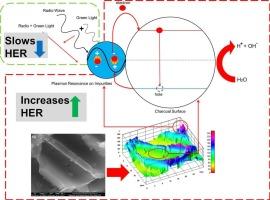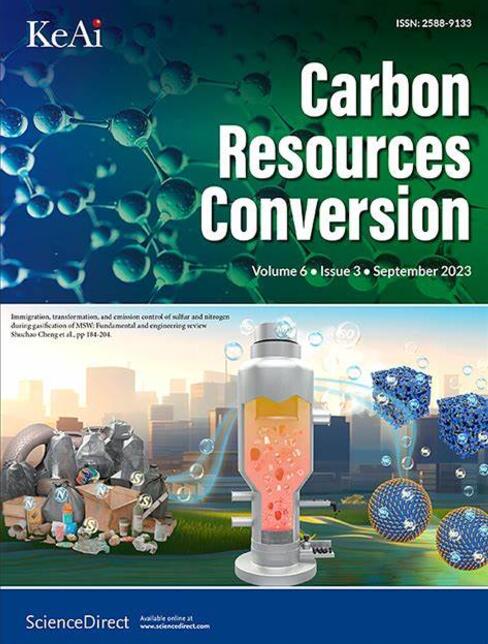The impact of radio–green light interaction on hydrogen evolution reaction inhibition of carbon based electrophotocatalyst
IF 7.5
3区 环境科学与生态学
Q2 ENERGY & FUELS
引用次数: 0
Abstract
This study investigates the effects of radio wave frequencies (470 MHz, 670 MHz, and 870 MHz) on hydrogen evolution reaction (HER) during water electrolysis using activated charcoal as an electrophotocatalyst. The results reveal that a frequency of 870 MHz produced the highest hydrogen concentration (7775 ppm), followed by 670 MHz (7016 ppm), and 470 MHz (4219 ppm). In contrast, electrolysis without radio frequency application resulted in 8271 ppm of hydrogen suggests the interaction between radio and light interaction inhibits hydrogen production. FTIR analysis identified multiple functional groups on the activated charcoal surface, including OH, C=O, and C-Cl, which influence the material’s interaction with electromagnetic fields. SEM and EDS characterizations revealed a hierarchical porous microstructure with elemental inclusions such as Si, Al, and Cl that contribute to surface polarization. This study proposes that surface plasmon resonance (SPR) is induced by metal impurities on the activated chcarcoal surface, enhancing the local electric field and improving HER. The complex interaction of functional groups, elemental composition, and radio waves offers insights into optimizing activated charcoal for improved HER efficiency.

无线电-绿光相互作用对碳基光电催化剂析氢反应抑制的影响
研究了无线电波频率(470 MHz、670 MHz和870 MHz)对活性炭电解过程中析氢反应(HER)的影响。结果显示,870 MHz频率产生的氢浓度最高(7775 ppm),其次是670 MHz (7016 ppm)和470 MHz (4219 ppm)。相比之下,没有射频应用的电解产生8271 ppm的氢,表明无线电和光相互作用之间的相互作用抑制了氢的产生。FTIR分析发现,活性炭表面存在OH、C=O、C- cl等多个影响材料与电磁场相互作用的官能团。扫描电镜和能谱分析表明,硅、铝和氯等元素夹杂物有助于表面极化。本研究提出活性炭表面金属杂质诱导表面等离子体共振(SPR),增强局部电场,提高HER。官能团、元素组成和无线电波的复杂相互作用为优化活性炭以提高HER效率提供了见解。
本文章由计算机程序翻译,如有差异,请以英文原文为准。
求助全文
约1分钟内获得全文
求助全文
来源期刊

Carbon Resources Conversion
Materials Science-Materials Science (miscellaneous)
CiteScore
9.90
自引率
11.70%
发文量
36
审稿时长
10 weeks
期刊介绍:
Carbon Resources Conversion (CRC) publishes fundamental studies and industrial developments regarding relevant technologies aiming for the clean, efficient, value-added, and low-carbon utilization of carbon-containing resources as fuel for energy and as feedstock for materials or chemicals from, for example, fossil fuels, biomass, syngas, CO2, hydrocarbons, and organic wastes via physical, thermal, chemical, biological, and other technical methods. CRC also publishes scientific and engineering studies on resource characterization and pretreatment, carbon material innovation and production, clean technologies related to carbon resource conversion and utilization, and various process-supporting technologies, including on-line or off-line measurement and monitoring, modeling, simulations focused on safe and efficient process operation and control, and process and equipment optimization.
 求助内容:
求助内容: 应助结果提醒方式:
应助结果提醒方式:


